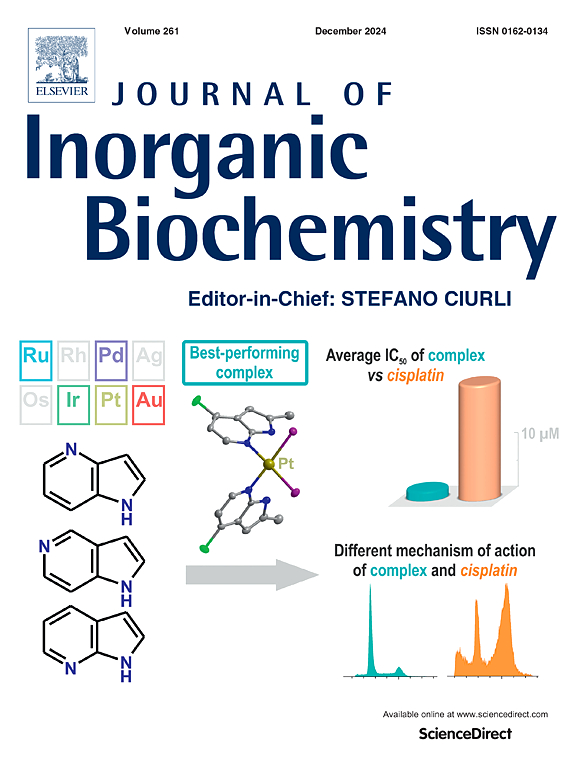Novel silver(I) complexes with fenamates: Insights into synthesis, spectral characterization, and bioactivity
IF 3.8
2区 化学
Q2 BIOCHEMISTRY & MOLECULAR BIOLOGY
引用次数: 0
Abstract
Six new Ag(I) ions complexes with N-phenylanthranilic, mefenamic, and niflumic acids have been synthesized. Three of them are binary complexes with the [Ag(L)] formula (where L represents N-phenylanthranilate (nfa), mefenamate (mfa), or niflumate (nif) ions), and the other three complexes are ternary with the formula [Ag(L)(phen)2]⋅nH2O (where phen - 1,10-phenanthroline). The complexes were characterized by elemental analysis, differential scanning calorimetry (DSC), X-ray fluorescence, powder X-ray diffraction, and single-crystal X-ray structure analysis. Additionally, techniques such as ESI-MS spectrometry, 1H NMR, UV–Vis, and FTIR spectroscopy were employed. The X-ray crystallography showed that in the solid [Ag(nif)] complex, the cation showed an unusual structure with coordination number 5, i.e. AgO3NC. The silver cation interacts with three niflumate anions, forming a two-dimensional coordination polymer. Complexes have potential antibacterial efficacy with varied minimum inhibitory concentration values (MIC) between 45.96 and 800 μM against multidrug-resistant Pseudomonas aeruginosa. Antibacterial combination therapy of Ag(I) complexes with chloramphenicol (CHL) and kanamycin (KAN) showed a very strong synergistic impact against P. aeruginosa with no cytotoxic effect on normal human fibroblasts. Complexes [Ag(nif)] and [Ag(nfa)] inhibit protein denaturation, bind to BSA via static quenching (kq = 0.65–1.08 × 1013 M−1 s−1). Furthermore, the formation of these complexes enhances the penetration of the drug across human membrane monolayers, which could improve bioavailability and therapeutic potential. The [Ag(nif)] complex demonstrates significant potential for topical dermal application due to its antimicrobial and anti-inflammatory properties. Notably, among all complexes evaluated, it displays the lowest BA/AB ratio (5.41), facilitating the most efficient transdermal permeation.

新银(I)配合物与雌酸酯:洞察合成,光谱表征,和生物活性
合成了六种新的银(I)离子与n -苯基苯甲酸、甲胺酸和尼氟酸配合物。其中三个是二元配合物,其分子式为[Ag(L)](其中L表示n -苯基氨基苯甲酸酯(nfa)、甲氨基甲酸酯(mfa)或硝烟酸酯(nif)离子),其他三个配合物为三元配合物,其分子式为[Ag(L)(phen)2]⋅nH2O(其中phen - 1,10-菲罗啉)。通过元素分析、差示扫描量热法(DSC)、x射线荧光、粉末x射线衍射和单晶x射线结构分析对配合物进行了表征。此外,采用ESI-MS光谱,1H NMR, UV-Vis和FTIR光谱等技术。x射线晶体学分析表明,在固体[Ag(nif)]配合物中,阳离子呈配位数为5的异常结构,即AgO3NC。银离子与三个烟叶酸阴离子相互作用,形成二维配位聚合物。配合物对多重耐药铜绿假单胞菌具有潜在的抗菌作用,最小抑菌浓度(MIC)在45.96 ~ 800 μM之间。Ag(I)配合物与氯霉素(CHL)和卡那霉素(KAN)联合抗菌对铜绿假单胞菌具有很强的协同作用,对正常人成纤维细胞无细胞毒性作用。配合物[Ag(nif)]和[Ag(nfa)]抑制蛋白质变性,通过静态猝灭与BSA结合(kq = 0.65-1.08 × 1013 M−1 s−1)。此外,这些复合物的形成增强了药物穿过人体膜单层的渗透,这可以提高生物利用度和治疗潜力。[Ag(nif)]复合物由于其抗菌和抗炎特性,在局部皮肤应用方面具有显著的潜力。值得注意的是,在所有评估的配合物中,它的BA/AB比最低(5.41),促进最有效的透皮渗透。
本文章由计算机程序翻译,如有差异,请以英文原文为准。
求助全文
约1分钟内获得全文
求助全文
来源期刊

Journal of Inorganic Biochemistry
生物-生化与分子生物学
CiteScore
7.00
自引率
10.30%
发文量
336
审稿时长
41 days
期刊介绍:
The Journal of Inorganic Biochemistry is an established international forum for research in all aspects of Biological Inorganic Chemistry. Original papers of a high scientific level are published in the form of Articles (full length papers), Short Communications, Focused Reviews and Bioinorganic Methods. Topics include: the chemistry, structure and function of metalloenzymes; the interaction of inorganic ions and molecules with proteins and nucleic acids; the synthesis and properties of coordination complexes of biological interest including both structural and functional model systems; the function of metal- containing systems in the regulation of gene expression; the role of metals in medicine; the application of spectroscopic methods to determine the structure of metallobiomolecules; the preparation and characterization of metal-based biomaterials; and related systems. The emphasis of the Journal is on the structure and mechanism of action of metallobiomolecules.
 求助内容:
求助内容: 应助结果提醒方式:
应助结果提醒方式:


